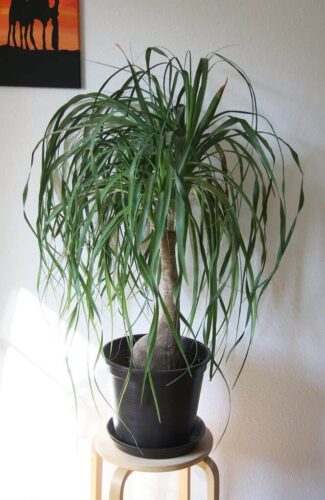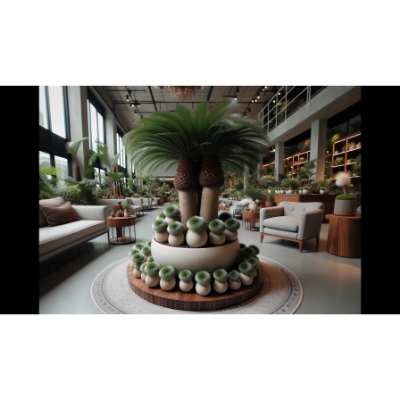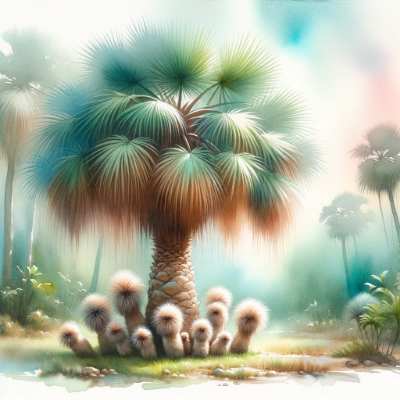A distinctive and well-liked indoor plant, ponytail palms (Beaucarnea recurvata) are distinguished by their long, thin leaves and bulbous stem. These slow-growing plants are a terrific addition to any house since they are reasonably simple to maintain and may grow up to six feet tall. As indoor plants, Ponytail Palm shouldn’t need to be pruned, however some gardeners may want to encourage their plants to develop many trunks. In this article, we will explore the methods for growing Multiple Heads on Your Ponytail Palm.
Yes, you can grow & propagate multiple trunks on ponytail palm by splitting the stem or multiplying pups. Stem Cutting requires cutting off plant’s top right above a leaf, while the pups emerges as the overall plant age. The cut should be made using a clean, sharp instrument. Next, use a clean knife to cut the stem in half. Make careful to prune the plant so that the core is visible. You should see several stems emerging from the cut spot after the plant has recovered and begun to thrive. To make even more trunks, repeat this method.
Ponytail palm multiple heads pups
There are a few efficient techniques you may use if you want your Ponytail palm to develop multiple heads.
Cutting the palm’s trunk is one strategy that may encourage the development of new heads. Trimming the stem’s tip requires precision and the use of a clean, sharp instrument.
The formation of multiple offsets or new heads will follow after allowing the plant to recover and begin fresh growth.
As an alternative, you may accomplish the desired result by propagating the plant’s side shoots or pups.
These puppies, which are naturally produced by the Ponytail palm as it ages and may be separated from the mother palm.
Wait for the puppies to reach a length of about 4 inches, and then gently separate them from the parent plant. Once separated, these puppies may be planted to develop into new Ponytail palm plants with multiple heads.





What is a Ponytail Palm?
A distinctive and intriguing plant is the Ponytail Palm, also known as Beaucarnea recurvata. Although it has the name “palm,” it is really a succulent plant that is indigenous to eastern Mexico. The name of the plant refers to its long, flowing leaves, which resemble a ponytail. Due to its distinctive form, it is a common indoor plant as well as a decorative plant in gardens and parks.
Ponytail Palm often have a broad, dome-shaped base that tapers into a narrow stem. It has a dramatic aesthetic impact as the long, thin leaves cascade down from the top of the stem. The plant has a sluggish growth rate of less than one foot per year and may reach heights and widths of up to six to eight feet and three to five feet, respectively.
The ponytail palm’s ease of maintenance is one of the factors contributing to its popularity as a houseplant. It can withstand dryness and favors sandy, draining soil with a neutral pH between 6.5 and 7.5. The plant needs intense light as well, although it should be shielded from direct sunshine. It is best to water sparingly and to let the soil dry up in between applications.
The ponytail palm is not only beautiful to look at, but it also has certain useful properties. The factory has a reputation for cleansing the air by eliminating pollutants like formaldehyde and xylene. As a source of fiber for ropes and textiles, its base has also been used for generations in its native Mexico.
Ponytail palm multiple heads propagation
There are a few methods you can employ to propagate ponytail palms and encourage the growth of multiple trunks. Let’s explore these methods in detail:
1. Trunk Cutting
How to do it:
- Take a sterile and sharp tool, like pruning shears or a knife.
- Carefully cut the top part of the ponytail palm’s stem.
- Make sure to remove any dead or damaged growth.
- Allow the cut end to callus over for a day or two to prevent infection.
- Plant the cutting in a well-draining potting mix and water lightly.
Why it works: Cutting the trunk of the ponytail palm stimulates the plant to produce offsets from the base. These offsets will grow into new heads, giving you a multi-trunked palm over time.
2. Pup Division
How to do it:
- Wait until the ponytail palm develops small offsets or “pups” at its base.
- Gently remove the pups by carefully separating them from the parent plant.
- Plant each pup in its own pot with well-draining soil.
- Water lightly and provide bright, indirect sunlight.
Why it works: Pup division allows you to transplant the young offshoots and grow them into independent ponytail palms, each with its trunk.
3. Seed Germination
How to do it:
- Collect seeds from the ponytail palm’s flowers.
- Soak the seeds in warm water for 24 hours to soften the outer seed coat.
- Plant the seeds in a well-draining potting mix, burying them just beneath the surface.
- Keep the soil consistently moist but not waterlogged.
- Provide warm, sunny conditions for germination.
Why it works: While this method takes more time and patience, it can result in multiple ponytail palms with unique characteristics.
Can Ponytail Palms Multiply?
Yes, Ponytail Palms can multiply. In actuality, as they age, they naturally produce “pups” or side shoots that may be split off from the mother palm and cultivated independently. You’ll need a clean, sharp paring knife or a sharp hori hori to propagate a ponytail palm. Before taking the puppies away from the mother plant, wait until they are about four inches tall. Cut the pup off close to the mother plant’s root, and then plant it in a new container with potting soil based on sand. To prevent contaminating the mother plant or the pup with germs or illness, it’s crucial to use a sterile knife.
To grow multiple trunks in ponytail palms, cut off the growing tip to stimulate growth or split the stem of a baby plant. Straight cuts usually bring multiple heads. Cutting the trunk is the most effective method.
Ponytail palms may also be reproduced by seeds and cuttings in addition to pups. But cutting propagation is favoured since it results in a plant that is genetically similar to the parent. Before planting, the cutting must be let to dry out for a few days to avoid rotting. Ponytail palms are an excellent investment for any indoor or outdoor garden since they grow slowly but ultimately may reach heights of up to 30 feet. Your ponytail palm may gradually grow several heads, or “pups,” along its trunk that can emerge into new plants if given the right care.
What is Growing Out of My Ponytail Palm?
When Ponytail palm matures, it grows out bulb-like offshoots called pups at the base of its stem.
These pups may develop into new plants if they are picked in the spring, one to five years after they first emerge and form roots.
A sharp knife or pruning shears should be used to cut the pup from the parent plant once it has grown to at least one-third the size of the parent plant. The pup must be taken out as near to the parent plant as you can without harming it. When the pup has been removed, place it in a container with a well-draining soil and water it gently until the roots have taken hold.
It’s crucial to bear in mind while taking care of a ponytail palm that it grows slowly and may take up to five years to double in size. Be cautious not to overwater it since it can store water in its bulbous trunk and is also drought-tolerant. Low-maintenance ponytail palms like temperatures between 55 and 75 degrees Fahrenheit and may grow in bright, indirect light.
The ponytail palm may blossom in addition to raising puppies. The plant produces male blooms on some plants and female flowers on other plants because it is dioecious. By looking at the blossoms that your plant produces, you may determine if it is male or female. The male flowers are smaller and do not generate seeds, while the female blooms are bigger and do.
How to Grow Multiple Heads on Your Ponytail Palm
If you want your ponytail palm to grow multiple trunks, there are two methods that work: splitting the stem or waiting for the plant to split itself.
Splitting the Stem
Cut off the plant’s top right above a leaf if you want to divide the stem. The cut should be made using a clean, sharp instrument. Next, use a clean knife to cut the stem in half. Make careful to prune the plant so that the core is visible. You should see several stems emerging from the cut spot after the plant has recovered and begun to thrive. To make even more trunks, repeat this method.
Waiting for the Plant to Split Itself
As an alternative, you might wait for the plant to naturally divide. This may occur organically as the plant develops or can be promoted by making sure the plant gets enough sunshine and isn’t overwatered. New stems that ultimately develop into new trunks will be produced when the plant divides.
Tips for Splitting a Ponytail Palm
It’s crucial to split a ponytail palm using a clean, hygienic knife or pruning instrument. The transmission of illnesses or pests will be minimized as a result. Before trying to break the stem, it is also crucial to make sure the plant is healthy and well hydrated. On a stressed or diseased plant, splitting the stem may do more damage than help.

What Happens if You Cut the Top off a Ponytail Palm?
Ponytail palms can have their tops cut off without the plant dying, however this might encourage the formation of additional trunks. The area where the top was removed will start to sprout little stems. It is possible to urge the plant to generate additional pups by doing this.
Check out detailed article when the top broke off from ponytail palm.
How Long Does It Take for a Ponytail Palm to Reach Full Size?
Ponytail palms may grow up to twelve inches each year under ideal circumstances, although this is unusual indoors. Instead, 2-4 inches of gradual, consistent growth every year are more typical.
Ponytail palms may grow up to 30 feet tall when planted outdoors in full light, but when cultivated inside, they normally reach maturity at a height of closer to 6 feet. The quantity of light, water, and nutrients a Ponytail Palm gets, as well as the size of the container it is planted in, all have an impact on how quickly it grows.
It’s crucial to provide a Ponytail Palm the ideal growing circumstances if you want it to develop more quickly. As the plant is susceptible to overwatering, this involves using well-draining soil and a container with enough drainage. It’s also advised to feed the plant often with a balanced fertilizer during the growth season.
It’s crucial to remember that Ponytail Palms grow slowly and don’t need to be pruned often. However, you may cut off the top growth from the stem to encourage your plant to sprout more trunks. This will promote new growth from the plant’s base, giving the illusion of a fuller look.
Will a ponytail palm grow from a cutting
Yes, ponytail palm can grow from cuttings because it is one of the propagation method used and here are the steps:
Finding a healthy ponytail palm and identifying the pup or side branch you wish to cut from the mother plant are the first two steps. Cut the pup from the mother plant using a clean, sharp paring knife. To enhance your chances of success, be sure to cut right at the pup’s base.
Take your cutting now and trim the leaves off the bottom to create a “stem.” Give your cutting a day or two to dry up so the wound may begin to heal. By doing so, rotting will be avoided, and the likelihood of effective propagation will rise. The cutting should be ready to be planted within a few days.
Use a soil mixture with good drainage before planting your cutting. For a nice blend, use sand and potting soil in equal proportions. After planting your clipping, softly water it. Because ponytail palms love dry soil, take care not to overwater them.
Keep the soil wet and place your container in a spot with bright, indirect light. You should begin to see new growth within a few weeks, which proves that your ponytail palm cutting has successfully rooted.
Do ponytail palms have babies?
Yes, ponytail palms have babies. The plant uses side pups that emerge from the base of the mother plant as a means of self-propagation. Once the plant reaches maturity, little miniature copies of the palm begin to sprout. The simplest technique to increase the population of the succulent palm is to propagate ponytail palms by removing these puppies. Wait until the puppies are around four inches long before cutting them away from the mother plant to reproduce the plant. To cut, use a paring knife that is clean and well-knifed. After the pup has been removed, trim the lowest leaves to create a “stem,” then let the cutting to dry for a day or two. This action is necessary to stop the wound from deteriorating and to promote healing. You may plant the cutting in potting soil with a sand foundation after it has dried up.
Ponytail palms seldom yield offsets or young plants, however they may sometimes generate stem or leaf cuttings. Before taking a baby ponytail palm from the mother plant in order to propagate it, make sure it is at least four inches tall. The young palm will now establish a root system that will enable it to live on its own. The baby ponytail palm may become a mature plant that produces pups and continues the propagation cycle with the right care and attention.
How do you separate ponytail palm pups?
Here is how to separate pups from a ponytail palm:
- Cut the pup from the mother plant using a clean, sharp paring knife. Cut the pup as closely to the root as you can without harming the mother plant.
- trim your cutting once the pup has been removed, then trim the leaves off the bottom to create a “stem.”
- Give your cutting a day or two to dry up so the wound may begin to heal. This will stop the decay.
- You may plant the clipping in drained soil after the wound has healed. Keep it in a bright, indirect light and water it in moderation.
- Ponytail palm pups are best propagated in the spring while the plant is actively developing.
Always leave at least one pup connected to the mother plant when splitting numerous puppies from a single plant. To gently separate the puppies by hand or with a clean knife, carefully dig the area surrounding the parent plant’s base to reveal the pups’ base. The puppies should be replanted in their individual pots with well-draining soil and little watering.
Ponytail palm multiple heads indoor care
I’ve discovered that providing the correct climate is essential for the Ponytail Palm’s development while caring for it inside. The three main elements to pay attention to are temperature, light, and humidity. Following my investigation, I have found the following:
The health of your Ponytail Palm is mostly dependent on sunshine, to start. It works best if you place it where there is plenty, indirect light. Its development is well suited to this kind of sunlight. However, take care not to expose it to direct sunlight, particularly if there are any new heads that are just beginning to grow. The leaves of these tender baby heads are extremely susceptible to scorching in direct sunshine. So keep in mind to balance the amount of light and shadow.
Let’s now discuss humidity. Ponytail palms have preferences, and in terms of relative humidity, they seem to do best in a drier setting. Keep your plant happy by aiming for a humidity level between 40% and 50%. For its development and general wellbeing, this equilibrium is advantageous.
Additionally, I’ve discovered some unique methods for promoting the development of multiple heads on a single Ponytail Palm. There is a way you may wish to try if you want a plant with multiple trunks. It entails chopping off the plant’s growing tip. As a consequence of this activity, the plant really starts to grow again from the cut site, producing more stems. It’s like giving your plant a new beginning, and you’ll eventually see these little stems sprouting and developing into fresh trunks.
The stem of a juvenile Ponytail Palm may also be split in another technique. You may encourage the plant to grow multiple trunks by delicately dividing the stem. This method may need a little more consideration and care, but it can provide fruitful outcomes.
How to Care for Your Ponytail Palm
Here are some tips on how to care for your ponytail palm:
- Ponytail palms demand direct, bright sunshine for growing. Keep the plant away from direct sunlight to prevent scorching of the leaves, but place it in a well-lit location.
- Ponytail palms are drought-tolerant plants that love to be kept dry, so they don’t need much water. Thoroughly, but seldom, water the plant, letting the soil fully dry out in between applications. Every 7 to 14 days throughout the growth season, water.
- Ponytail palms need a soil that drains properly. To increase drainage, use a cactus or succulent potting mix, or mix sand and tiny stones with standard potting soil.
- These plants are light feeders and don’t need fertilizing very often. During the growth season, apply a balanced, water-soluble fertilizer once a month.
- Repotting: Ponytail palms don’t need regular repotting. Repot a plant only when the roots get entrapped, which happens every two to three years.
- These slow-growing plants seldom ever need trimming. The leaves may be cut down to the proper length if they grow too long or are damaged, however.
Conclusion
I hope you get the answer on “Ponytail palm multiple heads”. Ponytail palms are distinctive and lovely houseplants that can bring a touch of the exotic into any room. Some gardeners may want to encourage their plants to have many trunks despite the fact that they are slow-growing and do not need trimming. You may do this by severing the stem or by waiting for the plant to do it naturally. Your ponytail palm has the potential to develop into a stunning, multi-trunked specimen with the right care and attention.
